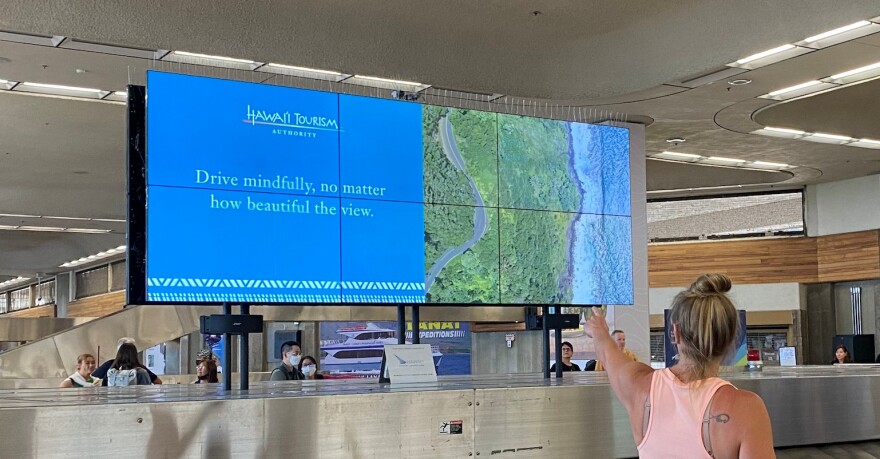This is the first week that visitors have officially been allowed back to parts of West Maui since wildfires swept through Lāhainā more than two months ago.
While residents have had mixed reactions, there's a different kind of tourism emerging.
Lāhainā native ʻEkolu Lindsey and his ʻohana have been restoring West Maui’s natural and cultural resources since the sugar plantation closed nearly 25 years ago. His organization Maui Cultural Lands oversees restoration projects from Hanaula to Honokowai.

“Basically, we’re removing invasive species along the riparian corridors to stabilize our cultural resources,” Lindsey said. “I call it 'pulling weeds.'”
Like many ʻāina-based organizations clearing waterways and restoring native forests, Maui Cultural Lands depends largely on volunteers. In recent years, that's included malihini, or visitors, said Maui Cultural Lands Board Member Duane Sparkman.
“We normally do it by ourselves and when a lot of people show up, it makes the work a lot easier,” Sparkman said. “There’s not very many people getting paid for this right now because the funding isn’t there. But we know in our hearts the work needs to get done.”
In the wake of the wildfires, malihini who want to give back may be the kind of visitor Maui could use, according to Kalani Kaʻanāʻanā, Chief Branding Officer of the Hawaiʻi Tourism Authority.
HTA partnered with Kanu Hawaiʻi to create an online booking platform for voluntourism activities that is set to launch at the end of October.
“We’re looking for respectful, compassionate, caring visitors who understand what’s happened,” Kaʻanāʻanā said. “Our communities on Maui went through something incredibly traumatic.”
He said voluntourism needs to be done with sensitivity. Not everyone on Maui is open to it.
“If I were speaking to the visitor right now it’s to go where you’re wanted and make sure that you approach these places with humility and respect,” Kaʻanāʻanā told HPR.
Rising demand for voluntourism
There’s been a rising demand for voluntourism globally said Mondy Jamshidi-Kent, founder of Naupaka Pacific, an organization focused on making regenerative tourism actionable. A 2008 study found 1.6 million people volunteer on vacation spending around $2 billion annually.
“I think that it will become more of a staple in how we interface and support Maui’s economy,” Jamshidi-Kent said. “And there definitely is an opportunity. A lot of folks want to help. They see the devastation, and they want to give back in a meaningful way.”
Jamshidi-Kent said she’s already seen volunteer opportunities that have sprung up organically from immediate relief efforts, and folks wanting to help out in whatever way they can. But there's also a more established long-term voluntourism initiative that HTA has been working on for over a decade.

“Strategically HTA has been on a path of encouraging more voluntourism. We recognize that people want to come here for a vacation, but we also truly believe that a volunteer activity as part of a broader itinerary for a visitor is a really great way for them to learn about our home, give back," Kaʻanāʻanā said.
"Our tagline is to take a trip that gives back."
One of the big drivers of this voluntourism movement is that travelers want that authentic experience, Jamshidi-Kent told HPR.
“People want to integrate with community, to learn something new, to really have an experience you can’t get anywhere else,” Jamshidi-Kent said. “What I’ve seen among our participants is a lot of millennials and then Gen Z are interested in protecting and healing the world that they’re inheriting. And so voluntourism is a natural offering.”
Regenerative force in a historically extractive industry
Voluntourism has the potential to be a regenerative force in an industry that has historically been extractive of the island's natural and cultural resources.
“You’ll get so much more out of your travel experience, by sharing the experience with those who love this space,” Lindsey said.
He said malihini who volunteer walk away with a better relationship to the islands and its people.
“They get their hands, they put their mana in that space and in return the mana comes back,” Lindsey said. “And then we walk around, we talk about the different plants, the archaeological structures, which way are they facing? What stories do the pohaku (stones) tell? What was life used to be in this area?”
Lāhainā was famed for its lush environment and once abundant water resources. The landscape was dominated by taro patches and ‘ulu groves.
Volunteer labor could go a long way in bolstering community-led efforts to restore this historic landscape and strengthen West Maui’s protection against future fires, Sparkman said.
"It's a simple concept that if we get these trees up and we build this shade layer then we have enough moisture that when an ember lands, the ember goes out," Sparkman said.
“It doesn’t continue to burn, it has no fuel. And that’s what we got to look at. Is we create these shade layers that have the potential to stop fires.”






